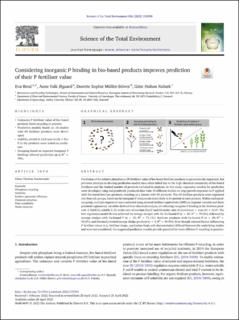| dc.contributor.author | Brod, Eva | |
| dc.contributor.author | Øgaard, Anne Falk | |
| dc.contributor.author | Müller-Stöver, Dorette Sophie | |
| dc.contributor.author | Rubæk, Gitte Holton | |
| dc.date.accessioned | 2022-10-11T14:06:32Z | |
| dc.date.available | 2022-10-11T14:06:32Z | |
| dc.date.created | 2022-07-01T11:02:54Z | |
| dc.date.issued | 2022-05-07 | |
| dc.identifier.citation | Science of the Total Environment. 2022, 836 . | en_US |
| dc.identifier.issn | 0048-9697 | |
| dc.identifier.uri | https://hdl.handle.net/11250/3025414 | |
| dc.description.abstract | Prediction of the relative phosphorus (P) fertiliser value of bio-based fertiliser products is agronomically important, but previous attempts to develop prediction models have often failed due to the high chemical complexity of bio-based fertilisers and the limited number of products included in analyses. In this study, regression models for prediction were developed using independently produced data from 10 different studies on crop growth responses to P applied with bio-based fertiliser products, resulting in a dataset with 69 products. The 69 fertiliser products were organised into four sub-groups, based on the inorganic P compounds most likely to be present in each product. Within each product group, multiple regression was conducted using mineral fertiliser equivalents (MFE) as response variable and three potential explanatory variables derived from chemical analysis, all reflecting inorganic P binding in the fertiliser products: i) NaHCO3-soluble P, ii) molar ratio of calcium (Ca):P and iii) molar ratio of aluminium+iron (Al+Fe):P. The best regression model fit was achieved for sewage sludges with Al-/Fe-bound P (n = 20; R2 = 79.2%), followed by sewage sludges with Ca-bound P (n = 11; R2 = 71.1%); fertiliser products with Ca-bound P (n = 29; R2 = 58.2%); and thermally treated sewage sludge products (n=9;R2=44.9%). Even though external factors influencing P fertiliser values (e.g. fertiliser shape, application form, soil characteristics) differed between the underlying studies and were not considered, the suggested prediction models provide potential for more efficient P recycling in practice. | en_US |
| dc.description.abstract | Considering inorganic P binding in bio-based products improves prediction of their P fertiliser value | en_US |
| dc.language.iso | eng | en_US |
| dc.publisher | Elsevier B.V. | en_US |
| dc.rights | Navngivelse 4.0 Internasjonal | * |
| dc.rights.uri | http://creativecommons.org/licenses/by/4.0/deed.no | * |
| dc.title | Considering inorganic P binding in bio-based products improves prediction of their P fertiliser value | en_US |
| dc.title.alternative | Considering inorganic P binding in bio-based products improves prediction of their P fertiliser value | en_US |
| dc.type | Peer reviewed | en_US |
| dc.type | Journal article | en_US |
| dc.description.version | publishedVersion | en_US |
| dc.rights.holder | © 2022 The Authors | en_US |
| dc.source.pagenumber | 7 | en_US |
| dc.source.volume | 836 | en_US |
| dc.source.journal | Science of the Total Environment | en_US |
| dc.identifier.doi | 10.1016/j.scitotenv.2022.155590 | |
| dc.identifier.cristin | 2036604 | |
| dc.relation.project | Norges forskningsråd: 194051 | en_US |
| dc.relation.project | Norges forskningsråd: 268338 | en_US |
| dc.source.articlenumber | 155590 | en_US |
| cristin.ispublished | true | |
| cristin.fulltext | original | |
| cristin.qualitycode | 2 | |

